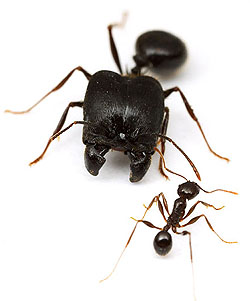
Out today is a preprint version (subscription only) of Corrie Moreau's Pheidole phylogeny. At first glance this seems a nice piece of work: the evolutionary history of one of the world's most diverse ant genera inferred from 140 species and 5 genes.
This is some extremely cool ant evolution research, and the first salvo from the nascent Pheidole working group. Once I get a chance to digest all 50+ pages I'll post the highlights.
source: Moreau, C. S. 2008. Unraveling the Evolutionary History of the Hyperdiverse Ant Genus Pheidole (Hymenoptera: Formicidae). Molecular Phylogenetics and Evolution, In Press, Accepted Manuscript.
More like this
A recent study by Gabriela Pirk in Insectes Sociaux provides me with an excuse to share this photo:
Pheidole creightoni major worker, California
Pheidole pegasus Sarnat 2008
Fiji
Pheidole rugithorax Eguchi 2008 - Vietnam
